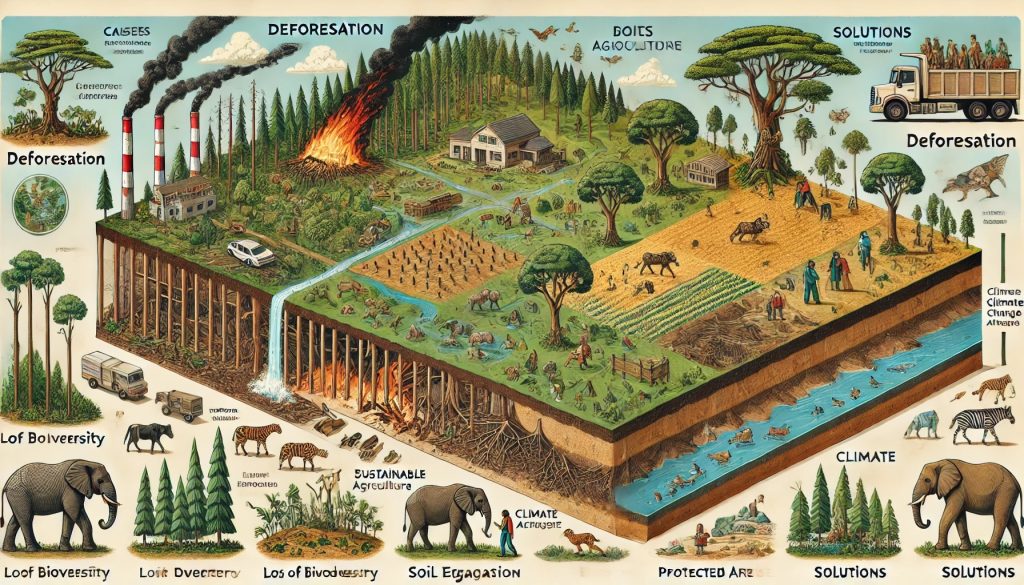Deforestation: Causes, Impacts, and Solutions
Introduction
Deforestation, the large-scale removal or destruction of forests, is one of the most significant environmental problems faced by the world today. It is driven by various factors such as agricultural expansion, logging, urbanization, and mining. Forests play a crucial role in maintaining ecological balance and supporting biodiversity. They regulate the climate, filter water, absorb carbon dioxide, and provide habitat for countless species. However, deforestation is taking a severe toll on the environment, threatening the sustainability of ecosystems and human societies.
The world’s forests are disappearing at an alarming rate. The Food and Agriculture Organization (FAO) reports that approximately 10 million hectares of forest are lost each year due to human activities. This destruction is particularly concerning in tropical regions such as the Amazon rainforest, the Congo Basin, and Southeast Asia, where forests are rapidly being cleared to make way for agriculture, urban development, and the extraction of resources. This essay explores the causes, effects, and potential solutions to deforestation, while also examining the urgent need for a global response to preserve and restore the world’s forests.

Causes of Deforestation
Deforestation is driven by a complex interplay of economic, social, and political factors. Human activities are the primary cause of deforestation, but they are often influenced by broader forces such as global trade, population growth, and technological advancements.
1. Agricultural Expansion
One of the leading causes of deforestation is the conversion of forests into agricultural land. As the global population continues to grow, there is an increasing demand for food, leading to the expansion of agricultural lands. In many developing countries, forests are cleared to make room for both subsistence farming and large-scale commercial agriculture. Cash crops like palm oil, soybeans, cocoa, and rubber often require large areas of forested land. Additionally, livestock farming, particularly cattle ranching, contributes to extensive deforestation, especially in countries like Brazil, where the Amazon rainforest is cleared for pastureland.
In many regions, agricultural expansion is facilitated by government policies that incentivize land clearing, often without consideration for long-term environmental consequences. The global demand for products such as soy, palm oil, and beef drives deforestation in key tropical regions, further exacerbating the problem. This shift from forested land to agricultural use alters the natural balance of ecosystems, disrupts wildlife habitats, and contributes to soil degradation.
2. Logging and Timber Harvesting
Logging, both legal and illegal, is another significant driver of deforestation. Forests are a valuable source of timber, which is used for construction, furniture, paper products, and fuel. Large-scale logging operations often involve the clear-cutting of forests, which leads to habitat destruction and loss of biodiversity. Illegal logging is particularly problematic in countries with weak environmental laws and enforcement, such as in parts of Southeast Asia, the Amazon basin, and Central Africa.
In addition to the direct removal of trees, logging activities often degrade the surrounding environment. Roads built to access timber can fragment ecosystems, making it harder for wildlife to move freely and find food. Furthermore, logging disturbs the soil, which can increase the risk of erosion and reduce the forest’s ability to regenerate.
3. Urbanization and Infrastructure Development
Urbanization and the expansion of infrastructure, such as roads, highways, and industrial zones, also contribute to deforestation. As the global population continues to grow and cities expand, more land is required for housing, transportation, and industry. In many parts of the world, forests are cleared to accommodate this development. Urban sprawl is particularly evident in developing countries, where rapid population growth is putting pressure on land resources.
In addition to direct deforestation, urbanization can lead to the fragmentation of forests, reducing their ability to support wildlife and ecosystem services. The construction of roads, for example, often isolates forest patches, making it difficult for animals to migrate and find suitable habitats. Additionally, as urban centers grow, they often lead to increased consumption of natural resources, further contributing to deforestation in surrounding areas.
4. Mining and Resource Extraction
The extraction of natural resources, including minerals, oil, and gas, is another major cause of deforestation. Mining activities, particularly in tropical regions, require the removal of large tracts of forested land. For instance, gold mining in the Amazon often involves clearing forests and using toxic chemicals, such as mercury, which pollute nearby rivers and soil. The extraction of oil and gas can also lead to deforestation, as infrastructure such as pipelines, drilling sites, and access roads require the clearing of forests.
In addition to the direct impacts on forests, mining activities contribute to soil erosion, water contamination, and the displacement of local communities. Mining in remote areas can be particularly destructive, as these regions often lack the regulations and oversight needed to ensure that activities are conducted sustainably.
5. Fires
Forest fires, whether natural or human-induced, play a significant role in deforestation, particularly in tropical regions. In some cases, fires are intentionally set to clear land for agriculture or development. In Southeast Asia, for example, large-scale fires are often used to prepare land for palm oil plantations. These fires can spread rapidly, consuming vast areas of forest and contributing to the destruction of biodiversity and the release of carbon dioxide into the atmosphere.
In addition to the direct loss of trees, forest fires can have long-lasting effects on soil quality, making it harder for forests to regenerate. The smoke from forest fires also contributes to air pollution, with detrimental health effects on nearby communities.
Effects of Deforestation
The effects of deforestation are widespread, affecting not only the environment but also human societies and the global climate.
1. Loss of Biodiversity
Forests are home to a significant portion of the Earth’s biodiversity. According to the World Wildlife Fund (WWF), approximately 80% of terrestrial species live in forests. Deforestation leads to habitat destruction, causing many species to lose their homes and food sources. This often results in a decline in wildlife populations, and many species are at risk of extinction due to habitat loss.
The Amazon rainforest, for example, is home to an estimated 10% of the world’s known species. When this rainforest is cleared, countless species are displaced or killed. The loss of biodiversity not only affects animals and plants but also has cascading effects on ecosystems, making them less resilient to environmental changes and disruptions.
2. Climate Change
Forests play a critical role in regulating the global climate. Trees absorb carbon dioxide (CO₂) from the atmosphere through photosynthesis, acting as carbon sinks that help mitigate the impacts of climate change. Deforestation releases large amounts of stored carbon into the atmosphere, contributing to global warming.
The burning of forests, especially in tropical regions, is responsible for a significant portion of global greenhouse gas emissions. According to the FAO, deforestation accounts for around 10-15% of global CO₂ emissions. This makes deforestation one of the largest contributors to climate change, exacerbating the global warming crisis.
Additionally, forests regulate local and regional climates by influencing rainfall patterns and providing moisture through transpiration. The loss of forests can lead to changes in precipitation, causing droughts in some areas and flooding in others. These changes can have severe consequences for agriculture, water resources, and human livelihoods.
3. Soil Erosion and Desertification
Trees and vegetation play a crucial role in maintaining soil health. Their roots help anchor the soil, preventing erosion by wind and water. When forests are cleared, the soil becomes vulnerable to erosion, which can lead to the loss of fertile topsoil. In regions where deforestation is widespread, this can result in desertification, where once-productive land becomes barren and unsuitable for agriculture.
In addition to soil erosion, the removal of trees can also affect water quality. Without trees to filter and absorb water, runoff can carry pollutants and sediment into rivers and streams, causing water contamination and harming aquatic ecosystems.
4. Disruption of the Water Cycle
Forests play a vital role in the global water cycle. Trees absorb water from the soil and release it into the atmosphere through transpiration, which helps maintain moisture levels in the air and regulate precipitation. Deforestation disrupts this cycle, leading to changes in rainfall patterns. In some regions, deforestation has been linked to reduced rainfall and the drying up of rivers and lakes.
The Amazon rainforest, often referred to as the “lungs of the planet,” is essential for the water cycle in South America. Deforestation in the Amazon is linked to changes in regional rainfall, affecting agriculture, water availability, and local ecosystems.
Solutions to Deforestation
Addressing deforestation requires a multifaceted approach that involves global cooperation, government action, and individual responsibility.
1. Sustainable Agriculture
One of the most effective ways to combat deforestation is to promote sustainable agricultural practices. Agroforestry, for example, involves integrating trees into agricultural systems, allowing for the production of food and timber while maintaining biodiversity and soil health. Practices such as crop rotation, organic farming, and reduced pesticide use can also help reduce the need for deforestation by making farming more sustainable.
Additionally, efforts to reduce the global demand for products linked to deforestation, such as palm oil, soy, and beef, can help curb the destruction of forests. Consumers can play a role by choosing sustainably sourced products and supporting companies that commit to responsible sourcing practices.
2. Forest Conservation and Protection
Protecting existing forests is essential for combating deforestation. This includes the establishment of protected areas, national parks, and conservation reserves where logging, agriculture, and development are prohibited or strictly regulated. Governments and international organizations must strengthen enforcement of environmental laws to prevent illegal logging and land grabbing.
The use of satellite technology and drones to monitor deforestation in real-time has been increasingly used to track illegal activities and provide data for law enforcement. Additionally, promoting indigenous rights and empowering local communities to protect their forests is crucial, as these communities often have a deep understanding of forest ecosystems and sustainable management practices.
3. Reforestation and Afforestation
Reforestation, the process of replanting trees in areas that have been deforested, is an important solution to reversing the effects of deforestation. Large-scale reforestation efforts can help restore ecosystems, sequester carbon, and protect biodiversity. Afforestation, which involves planting trees in areas that have never been forested, can also be beneficial in combating climate change and restoring degraded land.
Reforestation projects, such as those led by organizations like the Green Belt Movement in Kenya or the Bonn Challenge, aim to restore millions of hectares of forested land. These efforts not only mitigate climate change but also provide economic benefits by creating jobs and improving local livelihoods.
4. International Cooperation
Deforestation is a global issue that requires international cooperation. Agreements like the United Nations’ REDD+ (Reducing Emissions from Deforestation and Forest Degradation) initiative provide financial incentives for developing countries to reduce deforestation. Countries that commit to protecting their forests can receive funds from wealthy nations and international organizations in exchange for reducing emissions from deforestation.
Additionally, global certification systems, such as the Forest Stewardship Council (FSC), can help ensure that timber and other forest products are sustainably sourced. These initiatives encourage companies to adopt responsible practices and reduce the demand for illegally harvested timber.
10 Questions and Answers on Deforestation
1. What is deforestation?
Answer: Deforestation is the large-scale clearing, destruction, or conversion of forests into non-forest land uses such as agriculture, urbanization, or mining. This process involves the removal of trees and vegetation, leading to the degradation of ecosystems and loss of biodiversity. Deforestation often happens to make way for agricultural expansion, logging, infrastructure development, or the extraction of natural resources.
2. What are the main causes of deforestation?
Answer: Deforestation occurs due to a variety of human-driven and natural factors. The main causes of deforestation include:
- Agricultural Expansion: One of the primary drivers of deforestation, especially in tropical regions, is the conversion of forests into agricultural land. This includes the establishment of plantations for crops like palm oil, soy, and cocoa, as well as cattle ranching.
- Logging: Logging, both legal and illegal, involves the cutting down of trees for timber, paper products, and fuel. Commercial logging operations often lead to forest degradation and loss of biodiversity.
- Urbanization: As the global population increases, more land is required for housing, roads, and infrastructure. Urban sprawl leads to the clearing of forests to accommodate cities and towns.
- Mining: The extraction of natural resources, including minerals, oil, and gas, requires the removal of vast tracts of forested land, particularly in tropical rainforests.
- Fires: Forest fires, both natural and human-caused, are a significant factor in deforestation. In many cases, fires are intentionally set to clear land for agricultural purposes, especially in Southeast Asia and the Amazon.
3. What are the effects of deforestation on the environment?
Answer: Deforestation has far-reaching environmental consequences, including:
- Loss of Biodiversity: Forests are home to around 80% of the world’s terrestrial species. When forests are destroyed, many species face the threat of extinction as they lose their habitats. This leads to a decline in biodiversity and disrupts ecosystems.
- Climate Change: Trees play a vital role in absorbing carbon dioxide from the atmosphere. Deforestation releases significant amounts of CO₂ into the atmosphere, contributing to global warming and climate change. Additionally, the loss of trees reduces the Earth’s capacity to sequester carbon, further exacerbating the problem.
- Soil Erosion: Trees help bind the soil together with their roots. When forests are cleared, the soil becomes loose and prone to erosion. This can lead to the loss of fertile topsoil, making the land less productive for agriculture and increasing the risk of landslides.
- Disruption of the Water Cycle: Forests are critical in regulating the water cycle. Trees absorb and release water through transpiration, maintaining moisture levels in the atmosphere and ensuring the availability of freshwater resources. Deforestation disrupts this cycle, leading to droughts or flooding.
- Global Warming: The loss of forests exacerbates global warming. As trees are cut down and burned, they release stored carbon into the atmosphere, increasing the concentration of greenhouse gases and contributing to the warming of the planet.
4. What are the social and economic impacts of deforestation?
Answer: While deforestation has detrimental effects on the environment, it also impacts local communities and the global economy:
- Impact on Indigenous Communities: Many indigenous peoples rely on forests for their homes, livelihoods, and cultural practices. Deforestation leads to displacement and loss of traditional ways of life.
- Economic Dependency: In some countries, deforestation is seen as a means of economic development. Clearing forests for agriculture, logging, and mining creates jobs and generates revenue. However, this short-term economic gain is often outweighed by long-term environmental costs, such as reduced agricultural productivity, increased health care costs due to pollution, and the depletion of natural resources.
- Agricultural Decline: Although deforestation initially increases available land for agriculture, it can lead to a reduction in soil fertility and productivity over time. This creates a cycle of degradation, where new forested areas are cleared to compensate for the loss of fertile land.
5. What are the global impacts of deforestation?
Answer: The global consequences of deforestation are severe, impacting not just the regions where deforestation occurs but the entire planet:
- Contributing to Global Warming: Deforestation is responsible for around 10-15% of global greenhouse gas emissions, making it one of the leading causes of climate change.
- Loss of Carbon Sequestration: Trees play a crucial role in absorbing carbon dioxide (CO₂) from the atmosphere. When forests are cut down or burned, this stored carbon is released, exacerbating the greenhouse effect and global warming.
- Impact on Global Water Systems: Forests, particularly tropical forests, play a significant role in maintaining global water cycles. Deforestation disrupts these cycles, affecting rainfall patterns and the availability of fresh water in various regions.
- Threat to Global Food Security: Deforestation, particularly in tropical regions, often involves clearing land for monoculture crops like palm oil and soy. This reduces biodiversity, making agriculture more vulnerable to pests, diseases, and changing climate conditions, which can threaten food security.
6. How does deforestation affect wildlife and ecosystems?
Answer: Deforestation directly harms wildlife and ecosystems:
- Habitat Loss: Forests provide critical habitats for a vast array of species. When forests are destroyed, animals lose their homes, leading to population declines or extinction.
- Disruption of Ecosystems: Forests are complex ecosystems that support a wide range of species, each playing a specific role. Deforestation disrupts these ecosystems, causing cascading effects on food chains, nutrient cycling, and ecosystem services.
- Fragmentation of Habitats: Deforestation often results in the fragmentation of ecosystems, isolating wildlife populations and preventing species from migrating, finding food, or reproducing. This can lead to inbreeding, reduced genetic diversity, and an increased risk of extinction.
7. What are the potential solutions to deforestation?
Answer: There are several solutions to deforestation, focusing on sustainable land use, forest conservation, and reforestation efforts:
- Sustainable Agriculture: Implementing sustainable farming practices, such as agroforestry and organic farming, can help reduce the need for deforestation. These practices integrate trees and other vegetation into agricultural systems, promoting biodiversity and preventing soil erosion.
- Forest Protection and Conservation: Establishing protected areas and national parks can safeguard forests from destruction. Strict enforcement of anti-logging laws and the promotion of sustainable logging practices are also essential.
- Reforestation and Afforestation: Planting trees in areas that have been deforested (reforestation) or in areas that were never forested (afforestation) helps restore ecosystems, improve soil quality, and mitigate the impacts of climate change.
- Reducing Demand for Deforestation-Linked Products: Reducing the global demand for products like palm oil, soy, and timber that contribute to deforestation can help curb its spread. This can be achieved through sustainable sourcing, certification programs, and consumer awareness.
8. What role do governments and international organizations play in addressing deforestation?
Answer: Governments and international organizations play a crucial role in combating deforestation:
- Legislation and Enforcement: Governments can implement and enforce laws to protect forests from illegal logging, land conversion, and unsustainable practices. This includes establishing protected areas, regulating land use, and promoting sustainable forestry practices.
- International Agreements: Agreements like the United Nations’ REDD+ (Reducing Emissions from Deforestation and Forest Degradation) program aim to incentivize developing countries to preserve forests in exchange for financial support. International organizations such as the World Wildlife Fund (WWF) and Greenpeace also work to raise awareness and lobby for forest protection.
- Financial Support: Governments, through international cooperation, can provide financial incentives for reforestation, sustainable agriculture, and forest conservation programs in developing countries.
9. What are the challenges in tackling deforestation?
Answer: Several challenges complicate efforts to address deforestation:
- Economic Pressures: In many developing countries, deforestation is driven by the need for economic development, such as agriculture and mining. Changing these economic models can be difficult without offering alternative livelihoods and sustainable solutions.
- Illegal Logging: Illegal logging is a major driver of deforestation, particularly in tropical rainforests. Corruption, weak governance, and insufficient enforcement of laws make it difficult to combat this problem.
- Global Demand for Resources: The increasing global demand for commodities like palm oil, timber, and beef drives deforestation in countries like Indonesia and Brazil. Shifting global consumption patterns to more sustainable products is challenging due to market pressures and lack of consumer awareness.
10. How can individuals contribute to preventing deforestation?
Answer: Individuals can play an important role in combating deforestation by:
- Supporting Sustainable Products: Buying products that are certified as sustainable, such as FSC (Forest Stewardship Council) certified timber or palm oil, helps reduce demand for products linked to deforestation.
- Reducing Paper Consumption: Reducing paper use and recycling can decrease the pressure on forests for timber and paper products.
- Raising Awareness: Individuals can raise awareness about the importance of forests and the need to protect them by engaging in advocacy and supporting environmental organizations.
- Supporting Reforestation Projects: Donating to or volunteering for reforestation projects helps restore forests that have been lost to deforestation.






